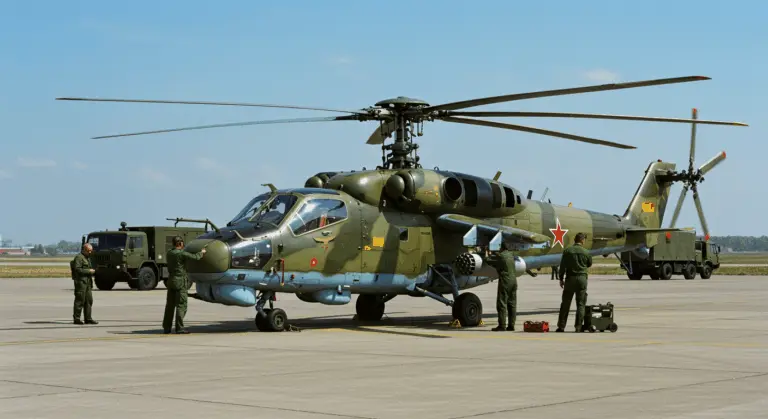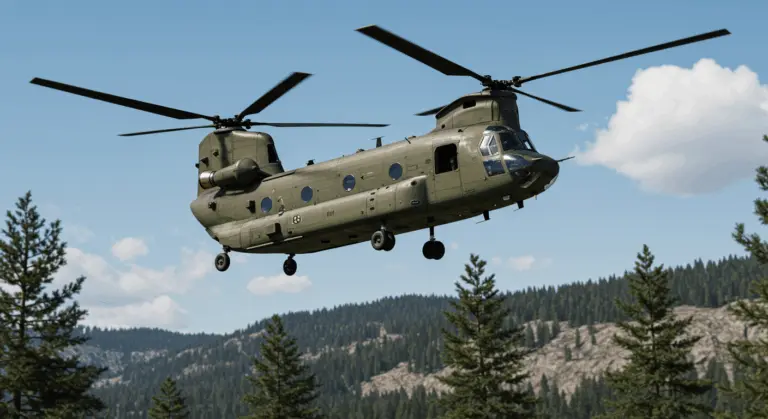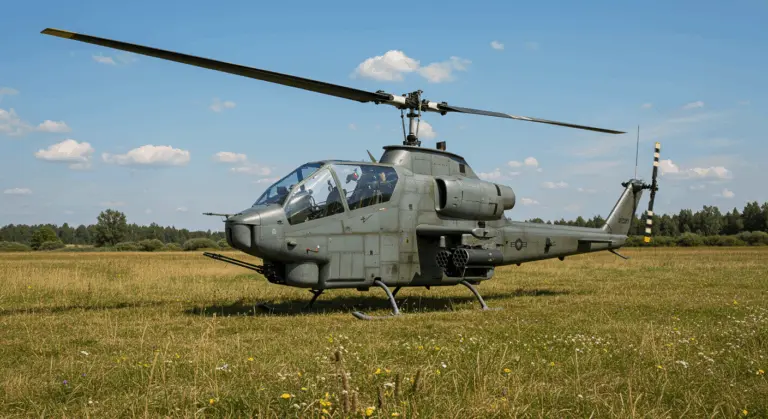Overview of the Mi-24 Hind Helicopter
The Mi-24 Hind stands as one of military aviation’s most iconic helicopters—a machine that defies conventional categorization. Born from the Mid Moscow Helicopter Plant’s innovative vision and entering service in 1972, this remarkable aircraft combines the roles of attack helicopter and troop transport. With over 50 nations in its operational roster, the Mi-24 has evolved beyond simple military equipment into a legend of the skies.
The Mi-24’s appearance is unmistakable with its tandem glass cockpits, large air intakes, and a silhouette frequently compared to some primordial beast of war. The helicopter’s aggressive appearance is backed by substantial firepower and armor, including:
-
A nose-mounted, four-barreled 12.7mm machine gun.
-
Stub wings with multiple hard points for missiles, rockets, and bombs.
-
Heavy armor plating protecting both the crew and vital engine components.
Drawing from analysis of American helicopter operations in Vietnam, the Mi-24 emerged as a revolutionary concept—a versatile platform that could deliver troops into the heart of battle while providing close air support. This dual-role capability sets it apart in the attack helicopter world, though dedicated specialists might edge it out in their respective domains.
History of the Mi-24 Hind
The Hind’s genesis traces back to the late 1960s at the Mid Moscow Helicopter Plant. Soviet designers, studying American helicopter tactics in Vietnam’s jungles, conceived something unprecedented: an aircraft that could transport troops while delivering heavy fire support. This revolutionary machine took flight in 1972.
NATO’s designation ‘Hind’ followed their established naming convention for Soviet rotorcraft. When measured against its American contemporary, the AH-1 Cobra, the Hind offered better speed and climb performance—though it sacrificed some agility in the bargain.
The Mi-24’s staying power is notable, surviving both the dissolution of the Soviet Union and the Warsaw Pact. It continues to serve in the Russian military and in the armed forces of dozens of other nations. Take aircraft number 406, delivered to the East German Air Force around 1977—it now rests in museum halls, a testament to the type’s historical significance. Today, the Mi-24 remains active in modern conflicts, including the Russo-Ukrainian War, demonstrating its enduring relevance on the battlefield.
Soviet-Afghan War – A Crucial Testing Ground
The Soviet-Afghan War (1979-1989) served as the Mi-24’s proving ground where theory met reality. In Afghanistan’s unforgiving mountains, the helicopter emerged as the Soviet forces’ primary aerial asset, excelling across multiple battlefield roles:
Afghan mujahideen fighters christened it ‘Satan’s Chariot’—a name that spoke to its terrifying battlefield presence. Its heavy armor was initially impervious to small arms fire, This dominance ended in 1986 when the United States began supplying the mujahideen with FIM-92 Stinger man-portable air-defense systems (MANPADS).
Stinger missiles changed tactics dramatically. Soviet pilots developed new approaches—soaring to higher altitudes that compromised accuracy, or skimming dangerously low where ground fire became lethal. These experiences led to important improvements in helicopter survivability and combat doctrine that would shape future Mi-24 variants.
Specifications of the Mi-24 Hind
-
Power plant: Two Asimov TV3-117 turboshaft engines (2,200 hp each)
-
Maximum Speed: 335 km/h (208 mph)
-
Range: 450 km (280 miles)
-
Service Ceiling: 4,500 m (14,750 ft)
-
Dimensions: 17.5 m length, 6.5 m height, 17.3 m rotor diameter
-
Weight: 8,500 kg empty; 12,000 kg maximum takeoff
-
Armament:
-
Primary Gun: 12.7mm Yak-B four-barrel gating gun
-
Hard points: Six pylons for rocket pods, 9M114 Storm (AT-6 Spiral) anti-tank missiles, bombs (up to 500 kg), and gun pods.
-
Transport Capacity: 8 fully equipped troops or 4 stretchers.
Variants of the Mi-24 Helicopter
The Mi-24 family tree sprawls across numerous variants, each tailored to specific operational demands and technological leaps:
The early Hinds weren’t without their growing pains, including lateral roll tendencies, weapon sighting limitations, and restricted pilot visibility. Engineers addressed these shortcomings through successive iterations—refining flight controls, upgrading targeting systems, and improving cockpit design. Remarkably, The Military Balance 2024 reveals Russia’s continued reliance on these veterans—108 Mi-24s and 56 Mi-35s still outnumber their sleeker successors: the Ka-52 fleet (85 total) and Mi-28 variants (roughly 100 across all modifications).
Operational History and Global Users
Over five decades, the Mi-24’s evolution from Soviet experiment to global phenomenon. Beginning with its baptism of fire in Afghanistan, the helicopter’s combination of firepower, armor, and transport ability has made it valuable across the world’s battlefields.
The Hind’s influence extends far beyond Russian borders, with exports reaching over 50 nations, making it one of the most widely distributed attack helicopters in history. Major operators include India, Poland, Czech Republic, Hungary, Bulgaria, and numerous African and Middle Eastern nations. From the Iran-Iraq War’s desert battles to African civil conflicts, from Syrian skies to Ukraine’s contested airspace—the Hind has written its story in smoke and thunder.
The Mi-24’s longevity stems from its robust design, adaptability to different mission profiles, and the continuous modernization efforts undertaken by various operators. Many countries have implemented upgrades to avionics, weapons systems, and survivability features to keep their Hind fleets relevant against evolving threats. Even as newer, specialized gunships enter service, the Hind’s dual-role versatility keeps it relevant. Many will likely thunder across battlefields for years to come.
Mi-24 in Modern Conflicts
The 21st century has witnessed the Mi-24’s continued battlefield relevance, nowhere more dramatically than in Syria and Ukraine. Russian and Syrian forces have deployed Hinds extensively throughout Syria’s complex conflict, where the helicopter’s heavy armament and battle-tested armor prove invaluable against opposition forces and terrorist groups.
Ukraine’s ongoing war presents a fascinating tactical mirror—Mi-24s clash on both sides of the conflict. Russia deploys its substantial Hind fleet alongside modern attack helicopters, while Ukraine’s inherited Soviet-era machines strike back against their former masters.
Modern battlefield survival demands constant adaptation:
-
Tactics: Flying at extremely low altitudes to avoid radar detection and employing infrared countermeasures against heat-seeking missiles.
-
Upgrades: Integrating advanced targeting systems, digital avionics, night vision compatibility, and the ability to deploy smart munitions.
Through these adaptations, this aging warrior maintains its fearsome reputation.
Cultural Impact of the Mi-24 Hind
The Mi-24 Hind extends beyond its military role into a unique place in popular culture. Its menacing silhouette and fearsome battlefield reputation have transformed it into an instantly recognizable icon—a symbol that resonates far beyond military circles.
Gaming culture has embraced the Hind with particular enthusiasm, where it frequently appears as a formidable gunship in major franchises such as:
-
Call of Duty: Featured in numerous titles across the Modern Warfare and Black Ops subseries.
-
Battlefield
-
Metal Gear Solid
-
Area
Cinema hasn’t ignored the Hind’s dramatic potential—Rambo III’s memorable helicopter duel in Afghanistan mirrors the aircraft’s real-world Afghan legacy. The Hind’s distinctive appearance has also made it a popular subject for scale modelers, aviation enthusiasts, and military history buffs. This cultural presence has made the Hind beyond mere military hardware—it’s become an enduring emblem of Cold War might.
Conclusion – The Legacy of the Mi-24 Hind
The Mi-24 Hind’s legacy stands among military aviation’s greatest achievements. Across five transformative decades, this extraordinary machine has challenged conventional thinking by combining the contradictory roles of attack helicopter and reliable troop transport.
The Hind’s global footprint tells its own remarkable story. With more than 50 countries having operated the helicopter, its influence on military doctrine and helicopter design has been felt worldwide. The concept of a ‘flying infantry fighting vehicle’ changed military aviation concepts, with echoes of this philosophy still shaping contemporary helicopter development.
Even facing today’s sophisticated threats, the Mi-24 endures through ongoing modernization and tactical evolution. Its fundamental robustness and operational versatility ensure continued service for years ahead.




